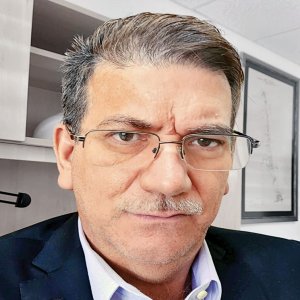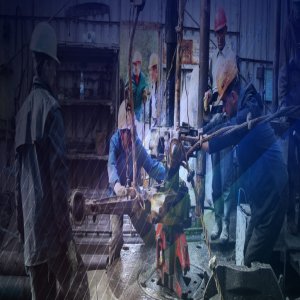
Effectively resisting wear and corrosion
Diode laser-based coatings optimize key applications in the oil and gas industry
Diode laser-based powder cladding can be used to implement numerous typical coating applications in the oil and gas industry more convincingly than conventional processes. For wear-resistant coatings and wear matrices, as well as for anti-corrosion coatings, the technology offers higher quality results while reducing process costs.
For quite some time, lasers had played only a minor role in coating applications in the oil and gas industry. Wear matrices or wear protection coatings for drill bits and stabilizers were usually realized using arc welding processes. Anti-corrosion coatings for drill pipes, pipelines or oil and gas tanks were often implemented as thermal spray coatings. However, powder-based cladding with diode lasers replaced these processes both technologically and economically. It enables low-pore and low-crack coatings that are gentler on components, more homogeneous, more precise, and more stable than conventional wear protection and anti-corrosion coatings, not to mention their better scores in terms of cost-effectiveness. For this reason, users from the oil and gas industry are increasingly turning to laser-based coating technologies.
PTA process with disadvantages for wear protection and wear matrices
For wear protection of drill bits and stabilizers, but also for the buildup of wear matrices for diamond-impregnated drill bits, the plasma powder deposition welding process, using a plasma arc (plasma-transferred arc = PTA) as heat source, has often been used in the past. In fact, this approach has a number of benefits. The metallurgical bond to the component ensures high stability. The coatings usually have a high density, while the wear matrices in particular — often centimeter-thick and usually made of tungsten carbide with diamond chips — can be effectively realized with the process. However, there are also significant disadvantages. If very thin coatings are required, such as for PDC bits, the technology reaches its limits: the layers easily become too thick and imprecise, which can impair the sharpness of the bits. Secondly, the PTA process intensely melts the component surface, which results in a strong mixture of base and coating material. This mixture reduces the surface hardness and increases the risk of explosion-causing spark strikes by entrapping steel particles from the component. In the case of diamond-impregnated wear matrices, this mixture additionally reduces the stone-grinding effect. If the deeper layer zones are reached during removal, there is also a risk of sparking there.
Irrespective of the coating objective, the PTA is also working on the key disadvantage of high heat input into the deeper-lying component zones. This can lead to a change in the degree of hardness and to deformations which then requires time-consuming and costly reworking. The coating of stabilizers for measuring processes is usually quite challenging. Such stabilizers are always made of non-magnetic steels in order to not impair the function of the measuring systems. However, these have higher coefficients of thermal expansion than magnetic steels, which favors heat-induced deformation of the component. Based on the heat-intensive PTA process, it is always very difficult to realize the coating of measuring systems’ stabilizers.
Laser cladding: Lower heat input and more homogeneous layers
The situation is much more convenient for users who already rely on diode laser-based powder cladding. This is because this process, which has now established itself in numerous industrial coating applications, retains the advantages of PTA technology while eliminating the already outlined disadvantages. Laser cladding also produces metallurgically bonded, stable coatings of high density, and is fully competitive with plasma powder cladding in terms of powder efficiency and deposition rate. However, compared to PTA technology, the high intensity of the laser irradiation with output powers in the multi-kilowatt range allows a much faster and therefore shorter melting of the component surface. Market-leading systems such as Laserline diode lasers also enable a finely graduated adjustment of the laser power to the component geometry within milliseconds while the process is running. This allows for more precise and thinner coatings than with the PTA approach. Furthermore, the process also ensures a reduced heat input and significantly less mixing of coating and base material. This results in more homogeneous coatings, enables more effective wear matrices and harder armor with a reduced risk of sparking. There are no critical deformations or changes in the degree of hardness. In many cases post-processing is completely eliminated, which significantly increases the efficiency of the process. Further economic advantages of the diode laser include its long service life and high energy efficiency. For instance, the Laserline systems are designed to last around 30,000 operating hours and require little maintenance. With an electrical efficiency of over 50 percent, they currently have the highest energy efficiency of all industrial lasers. As a result, coatings for drill bits and stabilizers can be realized more convincingly than with conventional coating processes, both technically and economically.
Better results in corrosion protection as well
As already indicated at the beginning, diode laser-based powder cladding opens up new possibilities beyond those for drilling tools. Anti-corrosive coatings for drill pipes, pipelines, storage and transport tanks can also be realized effectively and in high quality using this process. Compared to thermal spraying, which had often been used in the past for such anti-corrosion coatings, laser cladding has proven itself in several respects. Due to the metallurgical bond to the substrate, laser coatings are far more stable than thermal spray coatings, which adhere only by mechanical clamping and are thus more susceptible to impact and shock. This is particularly important for drill pipes and transport containers. Laser coatings also have a higher density; typical familiar pores and cracks from thermal spray coatings occur far less frequently with this type of coating. This aspect is important especially for internal coatings of pipeline pipes and tanks, since crude oil and natural gas are highly corrosive and attack the base material massively and quickly in the case of leaky coatings. Possible coating defects can be corrected safely and with limited post-processing effort. And last but not least, laser cladding has a far higher powder efficiency than thermal spraying, in which considerable amounts of the expensive coating materials are often get lost. The same basic economic advantages of diode laser technology also have positive effects on the coating of drilling tools: finely graduated, high-performance regulation within milliseconds while the process is running, long service life, and high energy efficiency.
Further developments in laser-based coating technology have made it even possible to achieve additional process advantages for rotationally symmetrical components such as rods or tubes. High-speed variants of laser cladding enable exceptionally high powder deposition rates for external coatings and thus a markedly economical series production. In particular, drill rods that are required in large quantities can be provided with the necessary anti-corrosion coatings quickly and cost-effectively.
Conclusion
With powder cladding based on diode lasers, the oil and gas industry now has a coating process that promises better results than the established processes in quite a number of technical and economic areas. Higher coating quality with lower process costs are very good arguments for using the technology on a broad front. To a considerable extent, these pluses can be attributed to the diode laser technology, which has made enormous progress over the past two decades and is now far less expensive than it used to be. Furthermore, it is no coincidence that this technology played a role in a completely different process environment than the oil and gas industry, namely in the production of lightweight pipes and tanks from fiber composite plastics. With the aid of diode lasers as heat sources, material-adapted tape joints are created as part of the respective manufacturing processes, which have better results and higher cost efficiency than conventional methods.
Laserline is a leading manufacturer of high-power diode lasers established in Germany in 1997. Its International presence extends into key sectors of the Mexican economy.



















